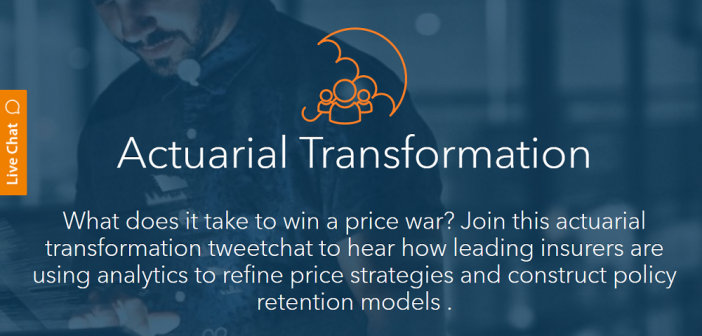Actuarial practice has always been analytical—so how much is advanced analytics disrupting this element of insurance? We discussed this issue in a recent #SASchat.
The importance of competitive pricing
Analytics is now being used in more and more areas in insurance, and particularly to tailor pricing more precisely to customers’ risk profile. This enables pricing to be more competitive, which is crucial when many customers use price comparison sites to select insurance. Robert Ruf, Sr Solutions Architect had a valid observation:
Advanced analytics and artificial intelligence are also helping insurers to automate processes, and therefore reduce costs. Margins are always challenged—being able to better optimise pricing and gain best benefits for the firm and customers is important. Felix Kugelman, Principal Business Solutions Managerreminded us of pricing dynamics:
“In a world where everyone compares tariffs on aggregators, competitive pricing helps to create smaller tariff segments. Therefore more customer-centric tariffs….Real-time pricing can be helpful for insurance companies to react faster to tariff changes [from]the competition.”
Analytics helped insurers to select the right customers, as well as customers selecting insurers. Optimizing portfolios starts when winning new customers. Insurers must select potential new customers by criteria which match their strategy and risk appetite.
The importance of speed for insurance customers
Price is therefore the most important criteria for most customers. However, customer experience also matters, including speed of decision making. After all, time is money, and the best tariff in the world is irrelevant if the decision is provided too late. However, is speed everything or, as some of my colleagues argued, only one factor? Here’s Jean-Michel Cornish, Sr Business Solutions Manager:
Speed is vital to preventing customers from going elsewhere. However, this is secondary to the quality of the decision. In other words, you need the right decision, in a timely way, rather than any decision, at speed. Thorsten Hein, Principal Product Marketing Manager agreed:
“Speed is nothing without control. Actuarial transformation needs to address the right customer with the appropriate tariff quickly, at the right time, while meeting the risk profile issued by the insurer.”
Kelly Jing Lu, Sr Business Solutions Manager noted that a fast decision could be an important predictor of future customer experience:
“…it’s important to impress your customers at the first interaction as a sign of a good experience to come.”
New data, changing practice
One of the key elements of actuarial transformation is new sources of data. These improve decision-making by providing more detailed information about customers. New sources of data in insurance are emerging from open banking, the Internet of Things, and satellites. Thorsten Hein suggested that external data sources were chiefly useful for comparing tariffs. However, both Colin Bristow and Marco Heidelberger felt that they could improve predictions and risk assessment. However, Felix Kugelman suggested that insurers might be best starting with their own data, and getting full value from that, before looking for further information.
For many contributors, the challenge was not so much new sources of data, but how insurers were going to combine traditional actuarial practice with new data science. Data science can help to unlock growth potential by improving micro-segmentation. Insurance tariffs are already rules-based, and the underwriting process only requires human decisions at certain points, so the stage is already set for the use of artificial intelligence. However, Thorsten Hein commented:
No takeover by technology
Contributors agreed that risk assessment and tariff development probably would never be fully handed over to technology. Thorsten commented:
“Why handing over completely? Expert judgement still is very relevant. You need to combine the experience of actuaries with the skills of data scientists. Actuarial transformation is a team sport.”
I agree with this. In my view, actuarial pricing will always require actuaries who truly understand nuances in data and actuarial risk profiles. Artificial intelligence is a great toolkit in the hands of great actuaries. A partnership between humans and technology is the way forward.
Join our next #SASChat
Please take a closer look at the upcoming #SASChat sessions and join renowned analytics experts and explore topics of your interest. You can also find there the list of experts participating in the above-mentioned #SASChat session on Actuarial Transformation.


1 Comment
Very informative article Waldemar! Thanks for sharing Your thoughts and summarizing most relevants points!